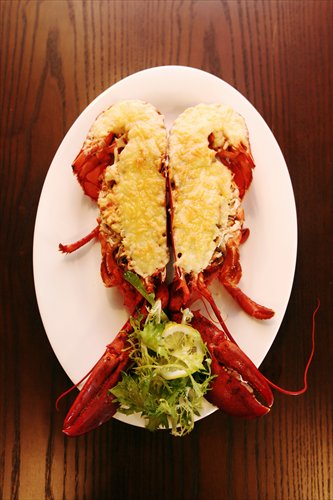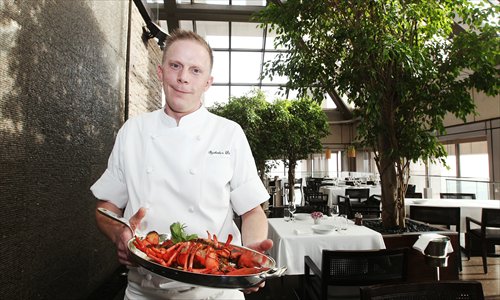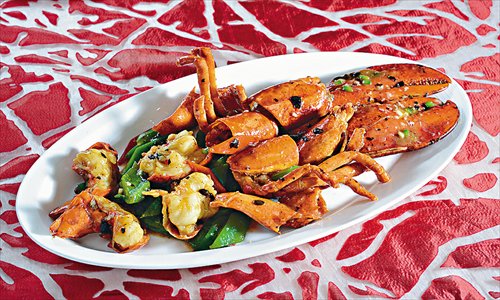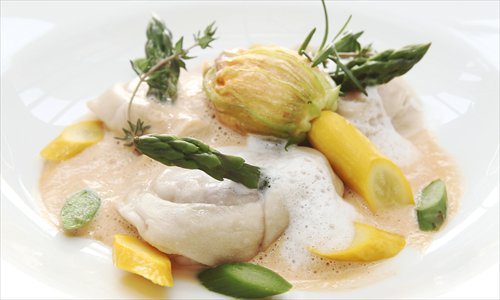A love affair with lobster
Prized crustacean is winning Chinese hearts and palates

Lobsters imported from the US, Canada, Australia and other countries are popular in China among foodies. Photo: Cui Meng/GT
Matching China's growing middle-class in recent years has been a burgeoning appetite for lobsters in the country.
"Lobsters are delicious, and also nice and red, a color that represents prosperity in the Chinese culture," said Chen Shanshan, a food writer, nutritionist and self-confessed lobster fanatic based in Shanghai and the US. "In the past, people thought of lobster as something fancy, but it's become more affordable, and people are now cooking it in more humble ways, such as for making soup or broths to accompany rice," said Chen.
According to a recent Associated Press (AP) report, in the last six years, exports of live and processed lobsters from the US to China have risen dramatically, from $2.1 million in 2009 to $90.5 million in 2014.
China now accounts for 12 percent of the US' total lobster export volume, as well as importing lobsters from Canada, Australia, South Africa and other countries.
Lobsters from the US, according to the AP report, are seen as a more affordable option than those from Australia.
The largest producer of lobster in the US is the state of Maine, with the upcoming summer months the peak season for lobster harvesting and consumption.
While still not cheap, at between $50 and $100 each at restaurants, rising incomes in China have meant that far more people can afford the prized delicacy than before.
"The prices are fine for many people now," said Chen.
" A lot of people I know also buy lobsters to cook at home themselves, [which is cheaper than eating at a restaurant."]

Chef Szabolcs Diviki from Park Hyatt Beijing's China Grill, a restaurant that is well known for its European-style lobster dishes. Photo: Cui Meng/GT
The 'humble' lobster
Guo Wen, the owner of Red Lobster restaurant which opened in Chaoyang district last December, said eating lobster is now a trend in China.
"Chinese people with disposable incomes have tried everything," said Guo. "There's nothing they haven't tasted. But now, they're more concerned about food quality."
Guo attributed the recent popularity of lobsters in China to a number of factors.
"People with money are eating healthy now," he said. "From a nutritional point of view, lobster is high in protein and low in fat."
Guo imports the lobsters he serves at his restaurant from Canada. Imported seafood, said Guo, is seen by customers as being safer and of a better quality, after a string of highly-publicized food scandals involving domestic products in the media in recent years.
One kilogram lobster at his restaurant costs 368 yuan ($59.4). He said that business had been going so well that he planned to open two other branches of the restaurant in Beijing within the year.
"In the previous years, lobsters, especially the bigger Australian lobsters, used to be considered a luxury food item, alongside shark fin and bird's nest," said Guo.
"Now along with the anti-corruption campaign, 'luxurious lobsters' no longer have a market. But due to more diverse channels for importing lobsters, dropping prices and the changing culture of dining, lobsters are coming back as a more down-to-earth food for Chinese."
If one is willing to go to the trouble of cooking at home, a 450-kilogram live lobster can be bought at around 200 yuan on online food outlet womai.com.
Simple dishes using lobster that can be made at home include lobster salad, lobster with spaghetti or rice, and lobster soup, said Chen. She noted that lobster with spaghetti was a favorite of her 3-year-old daughter.
Chen said she had tried cooking lobster dishes in various ways at home.
"Overall, it's a convenient ingredient. Some lobsters on the market are already pre-cooked, and you can just boil the live ones," said Chen.
"For me, a lobster dish basically goes with every kind of wine, except the stronger ones like Cabernet Sauvignon."

Lobster fried with Chinese fermented soy bean sauce. Photo: CFP

Lobster ravioli prepared by chef Diviki. Photo: Cui Meng/GT
Chinese innovations
Besides classic Western-style lobster dishes, Guo's restaurant also serves dishes that better catered to Chinese diners' tastes.
In the West, lobster is traditionally served boiled, to preserve its delicate flavor, with little more than a nub of butter for seasoning, said Guo.
"But Chinese customers find this to be flavorless and lacking in oil," said Guo. "So we have [lobster dishes] with curry, black pepper and cheese."
Chen said that her favorite way of eating lobster was sautéed with ginger and scallion, an adaptation of famous Guangzhou dish that uses crab.
She said that the version of the dish using lobster was created by Cantonese migrants to Boston, where lobster is plentiful, several generations ago.
Other popular ways of eating lobster in China, said Chen, were sashimi style, in soups, or as a broth used to flavor rice.
"Western ways of preparing lobster tend to emphasize the natural taste," said Chen. "While Chinese ways of preparing of lobster usually add a lot of ingredients, like ginger and scallion, and sometimes the lobster meat will be pre-fried. The ways in which Chinese people cook lobsters have a greater emphasis on the overall taste, aroma and the color."
Between Chinese and Western ways of preparing lobsters, Chen said her preference was Chinese.
"After all, it's not easy for us to change old habits when it comes to dining," she said. "[The shortcomings] are it requires a lot of advanced techniques. Lobster meat pre-fried or stirred with starch do taste more tender and fresher, but it also means more calories."
Chen said from a restaurant's point of view, combining Chinese and Western cooking methods was likely the best way to attract customers.
"Nowadays, when introducing Western ingredients to the Chinese market, it is a common strategy to highlight how they can be used in Chinese cuisines in order to promote greater sales."
Western decadence
Szabolcs Diviki, chef de cuisine at Park Hyatt Beijing's China Grill restaurant, said that besides boiling or steaming lobster, there are also more elaborate ways of preparing the delicacy in European cuisine.
Dishes at the restaurant include ravioli of lobster, with a zucchini flower emulsion bisque and parmesan foam, and Boston lobster granite with garlic butter and spring vegetables.
"I am not surprised that Chinese customers enjoy lobsters so much now," said Diviki. "I have to say we sell a lot of lobsters these days, easily 50 or more each day."
Diviki said that among Chinese diners, grilled lobster was a favorite.
"Maybe it's because Chinese people like [to see] the shell of [the lobster]." Other popular choices, he said, were lobster linguini, lobster soup, and lobster served cold.
"Most people in France like to eat lobster cold, because when it's cold, you can [taste] it better. It has much more taste inside than when it's hot," said Diviki.
"You just cook it very quickly, like 8-10 minutes [for a 800 grams to 1 kilogram lobster]. And you make it cold, and eat it with mayo."
Phillip Taylor, chef de cuisine at Aria, China World Hotel, Beijing, said that lobster also matched well with Italian flavors.
"Lobster is a strong-flavored seafood which is quite rich. It works well with Italian flavors such as tomato, pancetta," he said. "Lobster with lemon grass, ginger, orange is also a perfect match."
One of the most popular dishes at the restaurant, said Taylor, was the roasted Boston lobster with squid ink tomato, crispy pancetta, squid ink pappardelle, asparagus, sundried tomatoes, hazelnuts and lobster bisque.
Taylor said he'd tried lobster at a number of restaurants in China, including lobster dishes with chilies, Sichuan pepper and other strong spices.
"For Western cooking, it is unusual to match the flavor of lobster with these strong flavors," he said. "But when you try the way the locals eat it, it does taste very nice, but very different."
Taylor is originally from Australia, which is famed for the delicate natural sweetness of its rock lobster. But he had an open-minded attitude to how lobster should be prepared.
"That's the beauty of different cultures. The various styles of cooking are very different, but both ways of cooking the lobster taste amazing," he said. "Food has no restrictions or borders."